All You Need to Know about Staying Safe in Seoul
1. Seasons of Seoul
Seoul enjoys a temperate climate with four distinct seasons. Indeed, the changing of the seasons has inspired Korean artists and poets for centuries. Watching the transformation in the landscape as the seasons pass is one of the many joys of living in Seoul. While the city might be at its most spectacular in spring and autumn, summer and winter have their considerable charms, too, making Seoul the perfect place to visit all year round.

1.1. Spring
Spring in Seoul begins in March and lasts until May. Temperatures range from a daily mean of 5.7 degrees Celsius in March to 17.8 degrees Celsius in May. Due to the influence of anticyclones, the skies are usually clear, although sand storms from the Gobi Desert region of China and Mongolia sometimes make an appearance, too. The air is also particularly dry during this time, so care should be taken when hiking so as to not cause forest fires. Spring flowers such as cherry blossoms, chrysanthemums, and azaleas can be seen everywhere, and the island of Yeouido—described as “Seoul’s Manhattan”—even hosts a very popular cherry blossom festival that should not be missed.
1.2. Summer
Beginning in June and ending in August, the Korean summer is hot and humid, with average mean temperatures peaking at 25.7 degrees Celsius in August. The Korean rainy season, or jangma, begins in mid-June and continues for about a month. Compared with some other countries that experience monsoon, however, the rains are not especially heavy, with monthly precipitation peaking at 383 millimeters in July. Green spaces in Seoul such as parks and mountains become especially verdant due to the moisture. Popular summertime activities in Seoul include biking, swimming, in-line skating, and windsurfing on the Hangang River.
1.3. Autumn
Autumn is a lovely time in Seoul. Temperatures start to cool, the sky is high and cobalt blue, and the hillsides are decorated with bright hues of gold and crimson. Seoul’s royal palaces, with their extensive gardens filled with maple, ginkgo, and zelkova trees, are especially colorful and make for perfect fall outings. Many Seoulites take to the mountains to enjoy the colors and bask in the natural beauty. Korean autumn begins in September and ends in November. Chuseok, the Korean harvest celebration, falls in autumn.
1.4. Winter
Winter in Seoul, which lasts from December to February, can get quite cold due to the Siberian high pressure systems that bring with them cold northwesterly winds. Temperatures sometimes drop to negative 15 degrees Celsius, and the Hangang River occasionally freezes solid. Generally speaking, Korea experiences a weekly cycle of three cold days followed by four mild days, a phenomenon known in Korea as samha saon. Heavy snow periodically falls on the city. When it does, parks and gardens are transformed into shimmering landscapes of white. Seollal, the Lunar New Year celebration, takes place in winter.

2. Travel Advice
Whether you’re traveling in a group or on your own, you can rest assured that Seoul is a safe place to visit. As long as basic safety precautions are taken, there shouldn’t be any problems to hinder your experience of the city. Here are a few tips to enjoy a safe and memorable trip to Seoul.
First, follow basic safety rules. Most parts of Seoul are safe to freely roam around day and night, even for women traveling alone. As long as basic safety precautions are taken, like avoiding dark alleys and parking lots, it is very unlikely you will encounter dubious or troublesome individuals.
In the event you encounter police in full riot gear, do not be alarmed. In most cases, the riot police are there as a precaution. Simply, keep out of the way of any confrontations that may occur.
In the event of an incident, go to the nearest police station or dial 112. If you are a victim of an assault or other crime, day or night, go to the nearest police station to file a report.
3. Taxi Precautions
- Check that the cab driver is using the meter and be sure to pay only the price that is shown on the meter, regardless of the number of people in your party (tolls are paid separately).
- You can ask the cab driver to give you a fare estimate for a trip to your desired destination.
4. Call Van Precautions
- Make sure that the driver understands exactly where you want to go, and always negotiate the price of the fare before you get into the vehicle.
- Call vans are black and larger in size than regular taxis. They do not have meter systems installed, so check the price before you get into the van.
5. Shopping Precautions
- It is recommended that you shop at stores that clearly list their prices.
- If you have requested that your purchase be delivered to you, take note of the number of items, the condition of the items, the date of delivery, and store contact information, and always ask for a receipt.
6. Restaurant / Street Vendor Precautions
- At restaurants, it is recommended that you check the prices on the menu before you order.
- Some street food carts may not display their prices. It is recommended that you ask about the prices before you order.
7. Tourist Police Services
- Street patrols of the seven major tourist areas in Seoul by 101 tourist police officers
- Crackdown of illicit activities, including overcharging by merchants and taxi drivers
- Tourist assistance and interpretation services in English, Japanese, and Chinese
- Resolution of disputes and complaints that may arise during travels
In the event of an emergency, please contact the relevant department listed below.
Police Department: 112 (for theft, assault, and other crimes)
Fire Department: 119 (for general accidents and ambulance)
Emergency Medical Information Center: 1339 (medical assistance for international visitors)
Tourist Information Center: 1330 (for any other tourism-related assistance)
8. Lost and Found
In the case that you lose or misplace any property during your travels, please contact the following lost and found centers or the Travelers’ Hotline.
8.1. Incheon International Airport Lost and Found Center
Location: Passenger Terminal (B1), West Side
Hours: 7:00 a.m. to 10:00 p.m. daily
Tel : +82-32-741-3110/3114
Email : [email protected]
Airport Police: +82-32-740-0112
8.2. KTX
Tel : +82-2-1599-7777
Hours : 8:00 a.m. to 10:00 p.m. daily
Website : http://www.letskorail.com/ebizbf/EbizbfForeign_pr16100.do?gubun=1
8.3. Subway
Lines 1 & 2 : +82-2-6110-1122 (City Hall)
Lines 3 & 4 : +82-2-6110-3344 (Chungmuro)
Lines 5 & 8 : +82-2-6311-6765/6768 (Wangsimni)
Lines 6 & 7 : +82-2-6311-6766/6767 (Taereung)
Lines 9 : +82-2-2656-0009 (Dongjak)
8.4. A’REX (Airport Rail)
Tel : +82-32-745-7777 (Gimpo International Airport)
Website : http://www.arex.or.kr/main.do
8.5. Travelers’ Hotline
Tel : 1330
9. In the event of an accident or a medical emergency
Contact the police at 112 or emergency medical help at 119. If you ask for an ambulance in English, one will be sent to your location. If you have travel accident insurance coverage, contact your insurance provider.
- You can dial 119 from anywhere in Korea, and your location will be automatically identified.
- Hours of operation : 24 hours/day, 365 days/year
- Available in 16 languages, including English, Chinese, and Japanese.
10. Hospitals with International Clinics
10.1. Asan Medical Center, International Healthcare Service
- Address : 88, Olympic-ro 43-gil, Songpa-gu, Seoul
- Tel : +82-2-3010-5001
- Website: http://www.amc.seoul.kr/asan/main.do [Kor, Eng, Chi, Jpn, Rus, Mon, Ara]
- Hours : 8:30 a.m. to 5:30 p.m. (weekdays only)
- Transportation : Walk from exit 1 of Jamsillaru Station (Line 2) to the hospital shuttle stop (arrives every 10 minutes); or take bus 4318 from exit 7 of Jamsil Station (Line 2).
10.2. Samsung Medical Center, International Healthcare Service
- Address : 80, Irwon-ro, Gangnam-gu, Seoul
- Tel : 02)3410-0200; 02)3410-6531 (Russian), 02)3410-1075 (Chinese)
- Website : http://samsunghospital.com/home/main/index.do [Kor, Eng, Chi, Ara, Fre, Ger, Hin, Mon, Por, Rus, Spa, Tha, Vie]
- Email : [email protected]
- Hours : 8:00 a.m. to 5:00 p.m. (weekdays), 8:00 a.m. to 12:00 p.m. (Saturday)
- Transportation : Walk five minutes to SMC from exit 1 of Irwon Station (Line 3)
10.3. Seoul National University Hospital, International Healthcare Service
- Address : 101, Daehak-ro, Jongno-gu, Seoul
- Tel : 02)2072-2890/0505
- Website : http://www.snuh.org/pub/ [Kor, Eng, Jpn, Chi, Mon, Rus, Ara, Fre, Vie, Spa, Ben, Ger, Tha, Hin, Por]
- Email : [email protected]
- Hours : 9:00 a.m. to 5:30 p.m. (weekdays) / 9:00 a.m. to 12:30 p.m. (Saturdays)
- Foreign language services : English, Chinese, Japanese, Mongolian, and Russian
- Transportation : Hyehwa Station (Line 4, exit 3)
10.4. Severance Hospital (Yonsei University Hospital), International Healthcare Service
- Address : 134, Sinchon-dong, Seodaemun-gu, Seoul
- Tel : 02)2228-5800/5810
- Emergency : 02) 2228 – 8888, 6566
- Email : [email protected]
- Website : http://www.iseverance.com/ [Kor, Eng, Jap, Chi, Rus]
- Hours : 9:30 a.m. to 12:30 p.m.; 1:30 p.m. to 5:30 p.m. (weekdays; office opens at 8:30 a.m.) / 9:30 a.m. to 12:30 p.m. (Saturdays; walk-in only)
- Transportation : Walk 15 minutes from exit 3 of Sinchon Station (Line 2) or take the shuttle bus in front of exit 1. The hospital is located next to the Yonsei University campus.
10.5. Seoul St. Mary’s Hospital (Catholic University of Korea), International Healthcare Service
- Address : 222, Banpo-daero, Seocho-gu, Seoul
- Tel : 02)2258-5745
- Emergency : 02) 2228 – 8888, 6566
- Website : https://www.cmcseoul.or.kr/page/main [Kor, Eng, Jap, Chi, Rus, Ara]
- Email : [email protected]
- Hours : 8:00 a.m. – 5:00 p.m. (weekdays) / 9:00 a.m. – 12:00 p.m. (Saturdays)
- Foreign language services : English, Chinese, Japanese, Arabic, Russian, French
- Transportation : Walk 5 minutes from exit 4 of Express Bus Terminal Station (Line 7, 9) or take the shuttle bus from exit 3 of Express Bus Terminal Station (Line 3)
11. Pharmacies
All pharmacies in Korea are marked with a “약” sign and are well stocked with Western medicine. Most over-the-counter drugs are only available at pharmacies, but basic over-the-counter drugs, like Tylenol or aspirin, can be purchased at convenience stores. Pharmacies are usually closed on Sundays, but many near major transportation hubs and subway stations often stay open.
Getting to Seoul
Incheon International Airport is the main port of arrival for most flights from outside Korea. Located approximately 1 hour from downtown Seoul, there are a number of convenient ways to get to the city from the airport.
1. Train (AREX)
AREX is a railway line that connects downtown Seoul with Incheon International Airport and Gimpo Airport. There are 2 classes of train available: the All Stop Train that stops at every station and the Express Train that runs non-stop between Incheon Airport and Seoul Station. Express Trains depart every 20 to 40 minutes from Incheon International Airport and take approximately 40 minutes. All Stop Trains leave every 5 to 10 minutes and take just under 60 minutes to get to Seoul Station. The Express Train costs 9,500 won each way, and the All Stop Train is 4,150 – 4,750 won.
2. Bus
Airport Bus : travel to all major areas of Seoul. Tickets are 5,000 to 15,000 won and the travel time is approximately 60 to 80 minutes, depending on traffic and the destination. Tickets can be purchased at designated ticket booths outside the passenger terminal, or fare can be paid in cash,T-money, or credit card (at Incheon Airport). More information on routes and schedules is available at https://www.airport.kr/ap/en/tpt/busRouteList.do.
*Discount for Families of 3 or more traveling together to Incheon Airport can enjoy a discount starting on Jan. 20th, 2017. The traveling party must consist of immediate family members and there must be children in the group for the discount to apply. If the travelingparty meets these conditions, one person will be able to ride free of charge. The discount applies to all 36 bus routes (including the regular airport bus routes).
Airport Bus Companies
– City Airport Logis & Travel :https://www.calt.co.kr/
– Airport Limousine :http://www.airportlimousine.co.kr
– Seoul Airbus :http://www.seoulairbus.com
– KAL Limousine :https://www.kallimousine.com
3. Taxi
There are 4 types of taxis: Standard, international, deluxe, and jumbo taxi vans. International taxis are 20 percent more expensive than standard taxis and drivers speak English, Japanese, or Chinese. Deluxe taxis are approximately 40 to 50 percent more expensive than standard taxis, but use larger, more luxurious sedans. Jumbo taxi vans can accommodate up to 8 passengers at once and are the same price as Deluxe taxi. Taxi stands for each type of taxi are located outside the arrival terminal.
Standard Prices to Downtown Seoul: An extra toll charge of 7,900 won for the Incheon International Airport Expressway will be added to what is displayed on the meter.
| Destination | Estimated Time
(min.) |
Estimated Fare
(KRW) |
|---|---|---|
| Incheon Int’l Airport ↔ Gimpo Int’l Airport | 40~50 | 31,000~34,000 |
| Incheon Int’l Airport ↔ Courtyard by Marriott
(Yeongdeungpo-dong) |
60~70 | 40,000~44,000 |
| Incheon Int’l Airport ↔ Grand Hyatt Hotel
(Hannam-dong) |
80~90 | 47,000~52,000 |
| Incheon Int’l Airport ↔ Shilla Hotel
(Jangchung-dong) |
90~100 | 50,000~55,000 |
| Incheon Int’l Airport ↔ Grand InterContinental
Hotel (Samseong-dong) |
80~90 | 53,000~58,500 |
| Incheon Int’l Airport ↔ Marriott Hotel
(Euljiro-dong) |
80~90 | 48,000~53,000 |
| Incheon Int’l Airport ↔ Grand Hilton Hotel
(Hongeun-dong) |
60~70 | 41,000~45,000 |
| Incheon Int’l Airport ↔ Myeong-dong | 80~90 | 47,000~52,000 |
| Incheon Int’l Airport ↔ Dongdaemun Market | 90~100 | 50,000~55,000 |
| Incheon Int’l Airport ↔ Namdaemun Market | 80~90 | 48,000~53,000 |
| Incheon Int’l Airport ↔ Namsan (N Seoul Tower) | 80~90 | 49,000~54,000 |
| Incheon Int’l Airport ↔ Insa-dong | 70~80 | 44,000~48,500 |
※Actual travel time and fare may be different.
※Estimated fares as of 2013
All you need to know about getting around Seoul
1. Subway Routes and Map
> View interactive subway map (provides information such as the train fare, time to destination, and more, PC-compatible only)
Seoul has an extensive network of public transportation and taxis. Consistently voted as one of the best in the world for its ease of use, cleanliness, and frequency of service, the Seoul subway system is one of the most efficient ways to travel aroundthe city. Trains run non-stop from approximately 5:30 am until midnight. All subway lines are color coded and stations display signs in Korean, English, and Chinese. To ride the subway, you must use a single or multiple journey pass. Single-journeypasses can be purchased in the subway stations, and require exact fare to your destination plus a 500-won refundable deposit. Multiple journey passes called Tmoney can be purchased at most convenience stores. Transfers between subway lines are free,and Tmoney users can transfer for free between bus and subway lines.
Smartphone and tablet users can download a variety of apps that give routes, times, and transfer information in English, including Seoul Subway, Metroid Korea Subway Info, and Subway Navigation by Kakao.
| Passenger | Tmoney | Ticket |
|---|---|---|
| Regular (19 years old and up) | 1,250 won | 1,350 won |
| Youth (13-18 years old) | 720 won | 1,350 won |
| Child (6-12 years old) | 450 won | 450 won |
※ The Airport Railroad Line and Sinbundang Line charge higher fares
※ 10 – 50 km: 100 won for every 5 km
※ After 50 km: 100 won for every 8 km
※ Tmoney card users receive a 100 won discount off the adult fare per ride.
2. Riding the Subway
1. Subway stations are clearly marked with color coded signs written in Korean and English, and each exit is numbered.
2. You can purchase single journey tickets at ticket vending machines located within the station. A 500 won deposit is required, which you get back at your destination when returning the card. (Skip this step if you have purchased a Tmoney transit card).
Select “Single Journey Ticket”
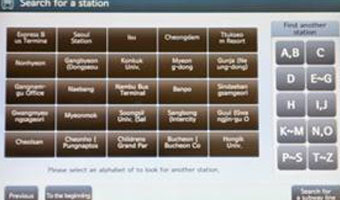
Choose your Destination

- Select the number of passengers, then insert money into the machine
- As you go through the turnstile, place your card over the Tmoney scanner.
- Transferring lines take place within the station. Follow the signs (color coded) to your desired line.
- After reaching your destination, place your card over the Tmoney scanner at the turnstile. If you’ve used a single-journey ticket, claim your 500 won deposit by returning the card to any “Deposit Refund Device.”
- If you have insufficient funds on your Tmoney card or single journey ticket, you can add money by using the fare adjustment machines located near the turnstiles.
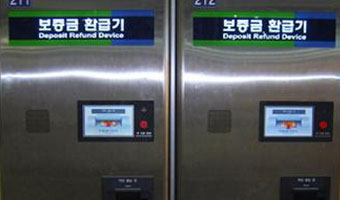
3. Taxis
Taxis in Seoul are an inexpensive and useful means of transportation. Abundant and inexpensive, it’s easy to flag one down on the streets, or find one of the many taxi stands located around major tourist destinations. All taxis use a meter, with slightlydifferent base rates for regular, international, deluxe, and jumbo cabs. Most taxis accept cash, credit cards, and Tmoney for payment. Rates depend on the class of taxi, length of journey, and time of day.

Regular taxi : are the cheapest and most common taxis in Seoul, and are easy to flag down in most neighborhoods. Most regular taxi are orange, but white, gray, and other colors are also common.
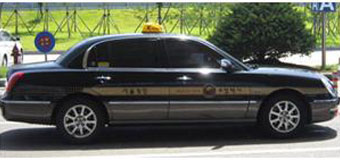
Deluxe taxi : have a higher flag drop charge and the fare per distance and idle time is higher than regular taxi, but Deluxe taxi do not have surcharges for late-night use. They are usually larger, more luxurious vehicles with exceptionallysafe service. Deluxe taxi are black with gold stripes, and can normally be found at major hotels and tourist locations.

Jumbo taxi : can fit up to 8 passengers and cost the same as deluxe taxi.
Warning: Please be cautious of the difference between Jumbo taxi, which are legal for the transportation of passengers, and call vans, which are intended for transporting passengers with freight and cargo goods and charge a much higher fare. The two may looksimilar, but call vans will have the words “VAN” or “CALL VAN” written on them and do not use a taximeter. All Jumbo taxi will have the words “JUMBO” written on them.
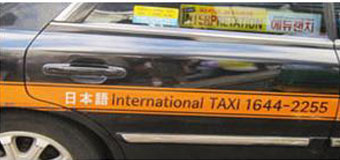
International Taxi : Specifically created for foreign tourists, drivers of these cabs are proficient in English, Chinese, or Japanese, with the language indicated on the side of the vehicle. International taxi can be reserved in advance, or flagged from the street. International taxi are black or orange with “International” written on the door. They are slightly more expensive than regular cabs, and can be chartered for blocks of 3 or more hours for a flat rate and will provide airport pickup service and trips for a flatrate.
Reservation : www.intltaxi.co.kr
Fare
| Fare | Regular | Deluxe/Jumbo |
|---|---|---|
| Base fare | 3,800 won/2km | 6,500 won/3km |
| Distance charge | 100 won/132m | 200 won/151m |
| Idle charge | 100 won/31s | 200 won/36s |
| Late-night surcharge | 20% from 12am~4am | None |
※International taxi charge a flat fares (65,000~90,000 won) from Incheon Intl Airport to destinations around Seoul.
Tip! Prepay Abroad, the Seoul International Taxi Service for Foreign Tourists
| Sections | Midsize Car | Deluxe or Jumbo |
|---|---|---|
| Section A Gangseo | 65,000 won | 90,000 won |
| Section B
Eunpyeong, Mapo, Seodaemun, Yangcheon, Yeongdeungpo, Guro |
70,000 won | 100,000 won |
| Section C
Jongno, Yongsan, Dongjak, Gwanak, Geumchon |
80,000 won | 110,000 won |
| Section D
Gangbuk, Seongbuk, Dongdaemun, Seongdong, Gangnam, Seocho |
85,000 won | 120,000 won |
| Section E
Dobong, Nowon, Jungnang, Gwangjin, Songpa, Gangdong |
90,000 won | 130,000 won |
4. Bus
Seoul’s public bus system is a well-developed, cheap, and convenient form of transportation. All buses are color coded: blue buses connect different districts of the city along main route, green buses connect subway stations and main blue bus routes with residential areas, smaller green maeul (local) buses travel shorter routes within a single district or neighborhood, yellow buses travel in a circulation route in the city center, and red buses connect the city with surrounding areas. However, due tothe lack of English signs and information at bus stops, Seoul’s buses can be more difficult to use for first time travelers to Korea. Major stops are usually announced in English and Korean.
Smartphone and tablet users can download apps for navigating the bus system in English or Korean, such as Seoul Bus.
Fare
| Bus | Adult | Youth (13-18) | Children (6-12) |
|---|---|---|---|
| Blue, Green | 1,300 won | 1,300 won | 450 won |
| Maeul (local) | 1,000 won | 550 won | 300 won |
| Yellow | 1,200 won | 1,200 won | 350 won |
| Red | 2,400 won | 2,400 won | 1,200 won |
※Tmoney card users receive a 100 won discount.
※Up to four transfers between buses and between bus and subways are free for Tmoney users. To transfer, make sure you scan the Tmoney card at the reader by the bus’ front or rear doors when exiting. Transfer must take place within 30 minutes (1 hour fortravel between 9pm and 7am) and 10km of disembarking.
5. TMoney
The TMoney card is a standard transit card that can be used on any public bus, subway, taxis, and even many convenient stores. After charging your card with the desired amount, funds are deducted as the card is used. TMoney cards offer a 100 won farediscount for buses and subways, and transfer discounts between buses and subways. To receive the transfer discount, scan your card when getting on and off the bus. (Note: You must scan your card when getting off the bus at your last transfer). The transferdiscount is only valid for 30 minutes between transfers.
More Infor:
The TMoney card can also be used to purchase items at Seoul’s traditional markets.
– The TMoney card can be used until 2018 at traditional markets such as Mangwon Market, Tongin Market, Gildong Market, Jeongneung Market, Shinwon Market, Yeongcheon Market, Donam Market, Dongbu Market, Ttukdo Market, Yongmun Market, and Huam Market.
– There is a 1,000 won discount on purchases of at least 10,000 won for visitors who make a purchase at a traditional market within 1 hour of using the TMoney card on public transportation.
Where to Buy
TMoney cards can be purchased and charged at most convenience stores, subway stations, and tourist information centers. Cards can be purchased for 3,000 won and charged with any amount. TMoney cards have no expiration date and any unused balance willremain on your card until used. If you wish to receive a refund for balances less than 20,000 won at convenience stores for a small fee. For balances greater than 20,000 won, refunds must be made at the TMoney headquarters (1st fl. TMoney Town, SeoulCity Tower Building, Namdaemun-ro 5-ga, Jung-gu, Seoul). The price of the card cannot be refunded.
6. TMoney Mpass
The TMoney Mpass is a transit card specifically designed for international visitors that require the use of public transportation multiple times a day. The card can be used up to 20 times a day for most subways and public buses. Just like regular TMoneycards, the Mpass can also be charged with additional funds to use at convenience stores, taxis, and more.
Where to Buy
The TMoney Mpass can be purchased at the tourist information centers located in front of gates 5 and 10 on the 1st floor of Incheon Int’l Airport, the Airport Railroad (AREX) Information Desk (B1 Incheon Int’l Airport), the Myeong-dongTourist Information Center, and Seoul Station Tmoney Town. The Mpass is good for one month from the date of purchase, and will only be activated upon use. The card expires at midnight of the last day.
| Card Type | 1-Day Pass | 2-Day Pass | 3-Day Pass | 5-Day Pass | 7-Day Pass |
|---|---|---|---|---|---|
| Price | 15,000 won | 23,000 won | 30,500 won | 47,500 won | 64,500 won |
| Price After 5 pm | 12,000 won | 20,000 won | 27,500 won | 44,500 won | 61,500 won |
※ Discounted prices available after 17:00
Refund Location:
- Incheon Int’l Airport (Terminal 1) Tourist Information Center
- Myeong-dong Tourist Information Center
- Seoul Station Tmoney Town
※ No refunds available in Airport Railroad (AREX) Information Desk. (Pass available for purchase only)
7. Tour Bus Parking Guide
To better accommodate the growing number of tour buses, the city of Seoul is working continually to provide parking spaces in the heart of Seoul. The following lists are locations where tour buses can park in Seoul. The lists have been divided into parkinggarages/attached parking lots, off-street parking facilities, street parking spaces (tour buses only), street parking time limits, and temporary parking.
Spot the Red Uniforms Marked With “i” (Walking Tourist Guides)
Tourist Information Centers
Incheon International Airport Tourist Information Center
-Hours: 7 a.m. – 10 p.m. / Languages: English, Chinese, Japanese
-Address: Incheon International Airport, Unseo-dong, Jung-gu, Incheon (In front of Exit 5 and Exit 10)
-phone: +82-32-743-3270, 743-3272
Incheon Int’l Airport Terminal 2 Tourist Information Center
-Hours: 7 a.m. – 120 p.m. / Languages: English, Chinese, Japanese
-Address: 272 Gonghang-ro, Jung-gu, Incheon (Terminal 2 – Arrival Gate)
-phone: +82-32-743-3269
Gimpo International Airport Tourist Information Center
-Hours: 10 a.m – 10 p.m / Languages: English, Chinese, Japanese
-Address: Gimpo International Airport, 76, Haneul-gil, Gangseo-gu, Seoul, Korea (International Terminal, Level 1, Arrivals Floor)
-phone: +82-2-2660-2486~7
Gangnam Tourist Information Center
-Hours: 10 a.m – 7 p.m (Open all year long)
-Languages: English, Chinese, Japanese
-Address: 161, Apgujeong-ro, Gangnam-gu, Seoul (Subway Line 3 – Apgujeong Stn. 2 minute walk from Exit 6.)
-phone:+82-2-3445-0111
Myeong-dong Tourist Information Center
-Hours: 9 a.m. – 9 p.m. / Languages: English, Chinese, Japanese
-Address: 181, Euljiro 2-ga, Jung-gu
-phone: +82-2-778-0333
Seoul Global Cultural Center
-Hours: 10:00 a.m. – 7:00 p.m. / Languages: English, Chinese, Japanese
-Address: 31-1 Myeongdong 2-ga, Jung-gu (M plaza 5th Floor, Seoul Global Cultural Center)
-phone: +82-2-3789-7961
Yongsan Station Tourist Information Center
-Hours: 9 a.m. – 6 p.m. / Languages: Chinese, Japanese
-Address: 3rd Fl. Yongsan Station, 55 Hangang-daero 23-gil, Yongsan-gu
-phone: +82-70-4224-4597
Yeongdeungpo Tourist Information Center
-Hours : 09:00 – 20:00 (May – Oct) / 10:00 -19:00(Nov – Apr) Languages: Japanese, Chinese
-Address : Yeongdeungpo Station (subway line 1) exit 6 / Mullae Station (subway line 2) exit 4
-phone : +82-2-2675-5600
Seoul Station Tourist Information Center
-Hours: 9 a.m. – 6 p.m. / Languages: Chinese, Japanese
-Address: 2nd Fl. Seoul Station, 405 Hangang-daero, Yongsan-gu
-phone: +82-70-4224-4596
by Visit Seoul




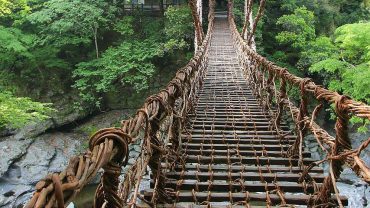
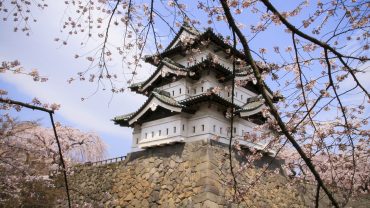
Comment (0)